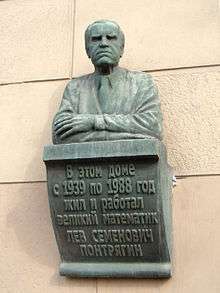Lev Pontryagin
| Lev Pontryagin | |
|---|---|
|
Lev Semenovich Pontryagin (left) | |
| Born |
3 September 1908 Moscow, Russian Empire |
| Died |
3 May 1988 (aged 79) Moscow, Soviet Union |
| Nationality | Soviet Union |
| Fields | Mathematics |
| Doctoral advisor | Pavel Alexandrov |
| Doctoral students |
Dmitri Anosov Vladimir Boltyansky Revaz Gamkrelidze Evgenii Mischenko Mikhail Postnikov Mikhail Zelikin |
| Known for |
Pontryagin duality Pontryagin class Pontryagin cohomology operation Pontryagin's minimum principle Bang–bang control Andronov–Pontryagin criterion |
Lev Semyonovich Pontryagin (Russian: Лев Семёнович Понтрягин, also written Pontriagin or Pontrjagin) (3 September 1908 – 3 May 1988) was a Soviet mathematician. He was born in Moscow and lost his eyesight due to a primus stove explosion when he was 14. Despite his blindness he was able to become one of the greatest mathematicians of the 20th century, partially with the help of his mother Tatyana Andreevna who read mathematical books and papers (notably those of Heinz Hopf, J. H. C. Whitehead, and Hassler Whitney) to him. He made major discoveries in a number of fields of mathematics, including algebraic topology and differential topology.
Work
Pontryagin worked on duality theory for homology while still a student. He went on to lay foundations for the abstract theory of the Fourier transform, now called Pontryagin duality. With René Thom, he is regarded as one of the co-founders of cobordism theory, and co-discoverers of the central idea of this theory, that framed cobordism and stable homotopy are equivalent.[1] This led to the introduction around 1940 of a theory of certain characteristic classes, now called Pontryagin classes, designed to vanish on a manifold that is a boundary. In 1942 he introduced the cohomology operations now called Pontryagin squares. Moreover, in operator theory there are specific instances of Krein spaces called Pontryagin spaces.
Later in his career he worked in optimal control theory. His maximum principle is fundamental to the modern theory of optimization. He also introduced there the idea of a bang-bang principle, to describe situations where either the maximum 'steer' should be applied to a system, or none.
Pontryagin authored several influential monographs as well as popular textbooks in mathematics. The fact that Pontryagin was legally blind since the age of 14, further underscores his scientific achievements.

Pontryagin's students include Dmitri Anosov, Vladimir Boltyansky, Revaz Gamkrelidze, Evgeni Mishchenko, Mikhail Postnikov, Vladimir Rokhlin, and Mikhail Zelikin.
Controversy and anti-semitism
Pontryagin was accused of anti-Semitism on several occasions. For example, he attacked Nathan Jacobson for being a "mediocre scientist" representing "Zionism movement", while both men were vice-presidents of the International Mathematical Union.[2][3] He rejected charges in anti-Semitism in an article published in Science in 1979,[4] claiming that he struggled with Zionism which he considered a form of racism.[3] When a prominent Soviet Jewish mathematician, Grigory Margulis, was selected by the IMU to receive the Fields Medal at the upcoming 1978 ICM, Pontryagin, who was a member of the Executive Committee of the IMU at the time, vigorously objected.[5] Although the IMU stood by its decision to award Margulis the Fields Medal, Margulis was denied a Soviet exit visa by the Soviet authorities and was unable to attend the 1978 ICM in person.[5] Pontryagin also participated in a few notorious political campaigns in the Soviet Union, most notably, in the Luzin affair.
Publications
- Pontrjagin, L. (1939), Topological Groups, Princeton Mathematical Series, 2, Princeton: Princeton University Press, MR 0000265
- 1962 - Ordinary Differential Equations
- 1962 - The Mathematical Theory of Optimal Processes
- 1963 - Foundations of Combinatorial Topology
See also
- Andronov–Pontryagin criterion
- Kuratowski's theorem, also called the Pontryagin–Kuratowski theorem
- Pontryagin class
- Pontryagin duality
- Pontryagin's minimum principle
Notes
- ↑ Mackenzie, Dana (2010), What's Happening in the Mathematical Sciences, Volume 8, American Mathematical Society, p. 126, ISBN 9780821849996.
- ↑ O'Connor, John J; Edmund F. Robertson "Nathan Jacobson". MacTutor History of Mathematics archive.
- 1 2 Memoirs, by Lev Pontryagin, Narod Publications, Moscow, 1998 (in Russian).
- ↑ "Soviet Anti-Semitism: Reply by Pontryagin". Science. 205 (4411): 1083–1084. September 14, 1979. doi:10.1126/science.205.4411.1083.
- 1 2 Olli Lehto. Mathematics without borders: a history of the International Mathematical Union. Springer-Verlag, 1998. ISBN 0-387-98358-9; pp. 205-206
External links
- Lev Pontryagin at the Mathematics Genealogy Project
- O'Connor, John J.; Robertson, Edmund F., "Lev Pontryagin", MacTutor History of Mathematics archive, University of St Andrews.
- Autobiography of Pontryagin (in Russian)
